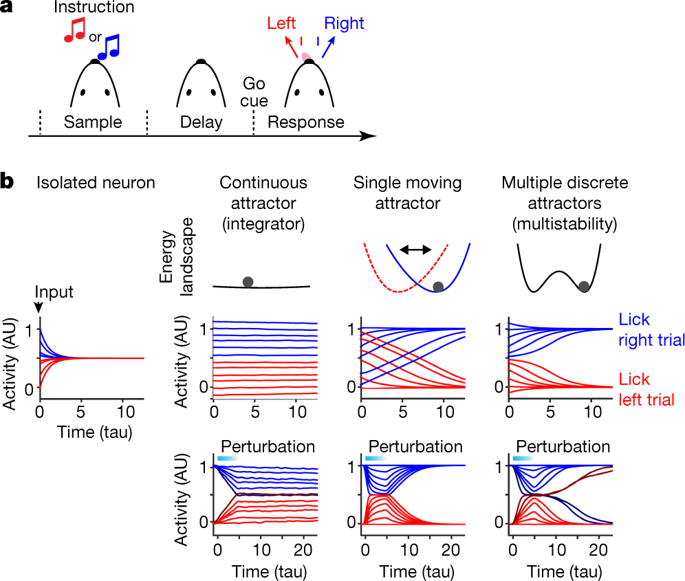Our official English website, www.x-mol.net, welcomes your
feedback! (Note: you will need to create a separate account there.)
Discrete attractor dynamics underlies persistent activity in the frontal cortex
Nature ( IF 50.5 ) Pub Date : 2019-02-01 , DOI: 10.1038/s41586-019-0919-7 Hidehiko K. Inagaki , Lorenzo Fontolan , Sandro Romani , Karel Svoboda
Nature ( IF 50.5 ) Pub Date : 2019-02-01 , DOI: 10.1038/s41586-019-0919-7 Hidehiko K. Inagaki , Lorenzo Fontolan , Sandro Romani , Karel Svoboda

|
Short-term memories link events separated in time, such as past sensation and future actions. Short-term memories are correlated with slow neural dynamics, including selective persistent activity, which can be maintained over seconds. In a delayed response task that requires short-term memory, neurons in the mouse anterior lateral motor cortex (ALM) show persistent activity that instructs future actions. To determine the principles that underlie this persistent activity, here we combined intracellular and extracellular electrophysiology with optogenetic perturbations and network modelling. We show that during the delay epoch, the activity of ALM neurons moved towards discrete end points that correspond to specific movement directions. These end points were robust to transient shifts in ALM activity caused by optogenetic perturbations. Perturbations occasionally switched the population dynamics to the other end point, followed by incorrect actions. Our results show that discrete attractor dynamics underlie short-term memory related to motor planning.Neuronal networks involving the frontal cortex follow discrete attractor dynamics to maintain short-term memories over times of seconds, much longer than the time-constant of individual neurons.
中文翻译:

离散吸引子动力学是额叶皮层持续活动的基础
短期记忆将时间上分开的事件联系起来,例如过去的感觉和未来的行动。短期记忆与缓慢的神经动力学相关,包括选择性持续活动,这种活动可以维持几秒钟。在需要短期记忆的延迟反应任务中,小鼠前外侧运动皮层 (ALM) 中的神经元显示出持续的活动,指示未来的行动。为了确定这种持续活动背后的原理,我们将细胞内和细胞外电生理学与光遗传学扰动和网络建模相结合。我们表明,在延迟时期,ALM 神经元的活动朝着与特定运动方向相对应的离散端点移动。这些终点对于由光遗传学扰动引起的 ALM 活动的瞬时变化是稳健的。扰动偶尔会将种群动态切换到另一个端点,然后是不正确的动作。我们的结果表明离散吸引子动力学是与运动规划相关的短期记忆的基础。涉及额叶皮层的神经网络遵循离散吸引子动力学以维持数秒的短期记忆,比单个神经元的时间常数长得多。
更新日期:2019-02-01
中文翻译:

离散吸引子动力学是额叶皮层持续活动的基础
短期记忆将时间上分开的事件联系起来,例如过去的感觉和未来的行动。短期记忆与缓慢的神经动力学相关,包括选择性持续活动,这种活动可以维持几秒钟。在需要短期记忆的延迟反应任务中,小鼠前外侧运动皮层 (ALM) 中的神经元显示出持续的活动,指示未来的行动。为了确定这种持续活动背后的原理,我们将细胞内和细胞外电生理学与光遗传学扰动和网络建模相结合。我们表明,在延迟时期,ALM 神经元的活动朝着与特定运动方向相对应的离散端点移动。这些终点对于由光遗传学扰动引起的 ALM 活动的瞬时变化是稳健的。扰动偶尔会将种群动态切换到另一个端点,然后是不正确的动作。我们的结果表明离散吸引子动力学是与运动规划相关的短期记忆的基础。涉及额叶皮层的神经网络遵循离散吸引子动力学以维持数秒的短期记忆,比单个神经元的时间常数长得多。





















































 京公网安备 11010802027423号
京公网安备 11010802027423号